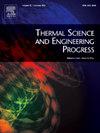Clinical study of intervertebral foramen endoscope combined with neurotriptyline in the treatment of degenerative lumbar spine diseases: Thermal radiation image inspection
IF 5.1
3区 工程技术
Q2 ENERGY & FUELS
引用次数: 0
Abstract
The study evaluated the clinical efficacy of foraminal endoscopy combined with neurotolin in the treatment of degenerative lumbar spine disease and monitored changes before and after treatment using thermal imaging techniques. All patients underwent foraminal endoscopic surgery and were treated with neurotolin after surgery. Before and after treatment, detailed clinical evaluation was performed on the patients, and the waist of the patients was scanned by thermal radiation image examination technology, and the changes of thermal radiation image before and after treatment were recorded. The therapeutic effect was evaluated by comparative analysis. After treatment with foraminal endoscopy and neurotolin, the pain degree of the patient was significantly reduced, the functional activity was significantly improved, and the quality of life score was also significantly improved. Thermal radiation image examination showed that the lumbar heat radiation distribution of the patients was more uniform after treatment, and the abnormal hot area was reduced, indicating that local inflammation and pain were effectively controlled. The results of statistical analysis show that the treatment method has a remarkable clinical effect. As a non-invasive evaluation method, thermal radiation image examination shows a good application prospect in monitoring the therapeutic effect.
求助全文
约1分钟内获得全文
求助全文
来源期刊

Thermal Science and Engineering Progress
Chemical Engineering-Fluid Flow and Transfer Processes
CiteScore
7.20
自引率
10.40%
发文量
327
审稿时长
41 days
期刊介绍:
Thermal Science and Engineering Progress (TSEP) publishes original, high-quality research articles that span activities ranging from fundamental scientific research and discussion of the more controversial thermodynamic theories, to developments in thermal engineering that are in many instances examples of the way scientists and engineers are addressing the challenges facing a growing population – smart cities and global warming – maximising thermodynamic efficiencies and minimising all heat losses. It is intended that these will be of current relevance and interest to industry, academia and other practitioners. It is evident that many specialised journals in thermal and, to some extent, in fluid disciplines tend to focus on topics that can be classified as fundamental in nature, or are ‘applied’ and near-market. Thermal Science and Engineering Progress will bridge the gap between these two areas, allowing authors to make an easy choice, should they or a journal editor feel that their papers are ‘out of scope’ when considering other journals. The range of topics covered by Thermal Science and Engineering Progress addresses the rapid rate of development being made in thermal transfer processes as they affect traditional fields, and important growth in the topical research areas of aerospace, thermal biological and medical systems, electronics and nano-technologies, renewable energy systems, food production (including agriculture), and the need to minimise man-made thermal impacts on climate change. Review articles on appropriate topics for TSEP are encouraged, although until TSEP is fully established, these will be limited in number. Before submitting such articles, please contact one of the Editors, or a member of the Editorial Advisory Board with an outline of your proposal and your expertise in the area of your review.
 求助内容:
求助内容: 应助结果提醒方式:
应助结果提醒方式:


